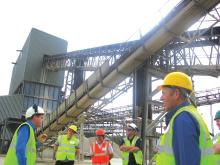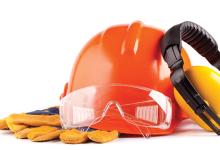Safety is the responsibility of everyone in the supply chain from equipment producer and quarry owner down to the individual worker and their colleagues. ABE reports
Improving the safety of quarry workers has been a key target for the industry over the last decade and these continual efforts have helped improve the sector's reputation. But to achieve the next target of zero lost time accidents at more than just a few sites will call for everyone to take responsibility.
"Everyone in the supply chain has a responsibility when it comes to health and safety," said
According to the UK's
"The level of safety and responsibility workers feel for each other is very dependent on the culture of the company and the individuals themselves," said Isles. "It is a case of how far down the line inter-dependence goes, whether they look out for each other and also if there is a system in place for people to report unsafe practices without the risk of victimisation.
"It is also if there is the willpower to stand up to more senior or longer serving workers - experience does not mean that it is safe to take a shortcut. Some workers may take shortcuts for the best of reasons and think that they are saving the company time and money but if they take a risk and things go wrong, then they are not only putting themselves in harm's way but also adding the risk of cost and delays through the need to investigate." According to Isles, this needs to apply to contractors working on quarry sites too and he said quarry owners need to treat them more like direct employees when it comes to safety.
Nonetheless, Isles believes that the new safety culture has changed the way the quarrying industry operates and many companies have now put safety at the top of their agenda. "But there is a still an attitude that some things should just be accepted and not challenged," he said. "Take spillages on site, for example, yes, it does happen but that doesn't mean that it is normal, however, there is still a culture that just accepts this problem."
Design fault
Isles believes that problems like spillages and blockages with plant that can present a significant safety risk are sometimes due to poor design on equipment. But unless the users provide feedback about the problems, equipment designers cannot be expected to find a design solution. "The input of designers to safety in quarries is important," he said. "Everyone in the supply chain has a responsibility." Problems do not just arise on old plant - problems are sometimes overlooked in the design of new equipment. Isles points to one of the winners in the UK's QPA health and safety awards last year as a prime example. "The quarry had a new asphalt plant installed at its site in South Wales but there was a problem with the overflow chute which became blocked on a regular basis by oversized material and the only way to free it was to rod it from below," he explained.
"The quarry manager arranged for a hatch to be installed above the bottleneck so that the worker could rod the blockage from above and avoid the risk of having hot material falling directly onto him. The solution was very simple, but effective." By feeding this kind of information back to the equipment supplier future buyers of the same plant could benefit but at the moment this kind of feedback is done on an ad hoc basis.
Isles said that there is a real need for more joined up thinking and has suggested that the
Communication
"Just because a piece of quarry machinery is new it does not mean that it is inherently safe," said Isles. "Buyers need to insist that basic safety equipment is standard on machines and not an optional extra." Through his role as health and safety director for the
Access and egress is one of the main issues tackled by Isles' list. "What may constitute good access when the machine is clean and new and standing on hard ground can be very different when there is built up dirt, it is raining and dark and the machine is on rough, uneven ground," he said.
"Having to step up to the first step, which can be at bumper height and start with a swing step access to a vertical ladder with round rungs does not make things easy. Some manufacturers are now improving their access with inclined, wider steps featuring handrails but not all are addressing the issue right across their product ranges.
"It is essential to have at least three points of contact at all time to minimise the risk of a fall but on many machines a simple task like opening the door make this difficult. There is also the hazard of cleaning windows to maintain good vision and access other maintenance points - these all need handrails or rails to clip a harness onto.
"The main point is that until the quarrying industry tells the equipment producers about the problems and demands change, then nothing will change. Communication throughout the supply chain is the key to achieving the next level of accident reduction."









